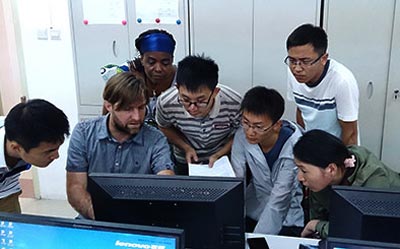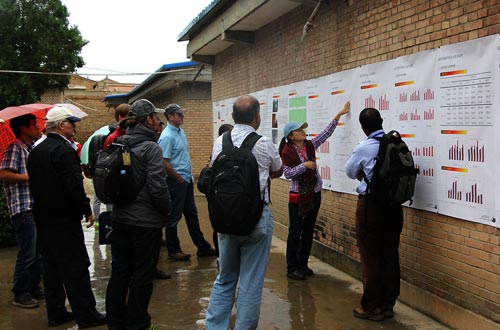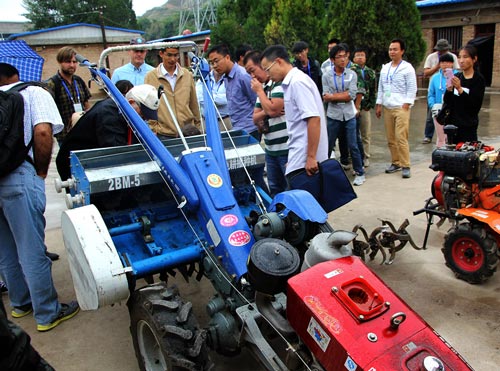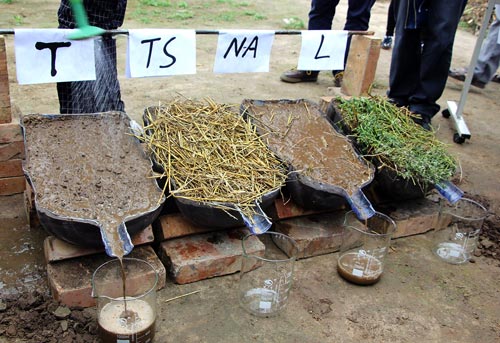CIMMYT-China, the Gansu Foreign Expert Bureau and Gansu Agricultural University (GAU) in Lanzhou City sponsored an international farming systems research workshop from 30 June–4 July 2015. Jack McHugh, CIMMYT-China Systems Agronomist, and Li Lingling, Vice Dean of the Agronomy Department at GAU, were the lead organizers of the event.

CIMMYT international conservation agriculture (CA) researchers and national scientists came together to build the agroecological capacity of researchers across China, discuss successes, present the science and practical agronomy that underpins CA, demonstrate and discuss farming systems research, and conduct field displays of CA benefits.
Bruno Gérard, Director of CIMMYT’s Global Conservation Agriculture Program (GCAP), led the workshop’s opening ceremony. Experts from Australia, Bangladesh and The Netherlands joined GCAP’s global team to present a diverse mix of experiences designed to inform participants, expand their research boundaries and encourage them to commit to future cross-regional collaboration on themes of sustainable intensification and natural resource management.

“Advanced on-farm guidance systems are generally at the demonstration level in China, but are now set to expand rapidly through cost reduction and research trends such as multi-vehicle coordination,” said Lan Yubin, Leader of the national precision agriculture (PA) R&D program at Southern China Agricultural University, who gave the keynote speech. CIMMYT-China and Lan Yubin, in collaboration with an Australian company, will conduct an applied PA workshop later this year.
“Should we force the Green Revolution on everybody…does it fit in all places?” asked Frédéric Baudron, CIMMYT Cropping System Agronomist, during the workshop discussion. Baudron went on to suggest considering a climate-based approach to agricultural development while exploring linkages between agriculture and nature. CIMMYT Agronomist Santiago López Ridaura expressed that yield alone is no longer good enough. Relevant, participatory, measurable, and specific objectives and indicators must be addressed through robust frameworks.

Mechanization across 19 countries in South Asia was presented by Enamul Haque from Murdoch University, Australia, who explained that two-wheel tractors are on the rise across the region, and that this should be viewed as an economic opportunity for China. Timothy Krupnik, CIMMYT Cropping System Agronomist, also reviewed farming systems in the region, where challenges that impact R&D include over-population, water scarcity and high prices.
“A 1°C rise in temperature means we’ll need 10% more water,” said M.L. Jat, CIMMYT-India Cropping Systems Agronomist, who offered invaluable insights into nutrient management and the future of crop production in South Asia.
Li Lingling closed the workshop by presenting the history of agriculture on the Loess Plateau. She highlighted an interesting fact: hundreds of years ago, Loess farmers recognized the dangers of erosion and soil water evaporation and introduced sand and gravel mulch as preventive measures.
At the end of Science Week, there was a full day of agricultural modeling led by Wageningen University’s Carl Timler. China Science Week has facilitated new connections and future collaborations that will help advance CA demonstration and extension. CIMMYT-China is now in talks with local universities and the University of Southern Queensland on further scientific exchanges and project development.

Other participants and presenters included Jeremy Whish, CSIRO Australia; Hailin Zhang, Director of Farming Systems Association at China Agricultural University in Beijing; John Maclean Bennett from the University of Southern Queensland; Shen Yuyin from the Grassland Institute at Lanzhou University; Yang Dantong from Southern China Agricultural University; Li Chaosu and Tang Yonglu from Sichuan Academy of Agricultural Science; Yang Haishui from Nanjing Agricultural University and Chai Chang, Director of the Agronomy Department at Gansu Agricultural University. Members of the Gansu Academy of Agricultural Science, Lanzhou University, the Chinese Farming Systems Association (Beijing) and Gansu Key Laboratory of Arid Land Crop Science, Lanzhou City contributed to organizing the event.
 Climate adaptation and mitigation
Climate adaptation and mitigation